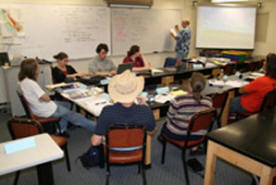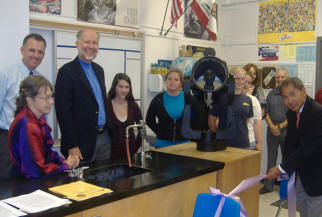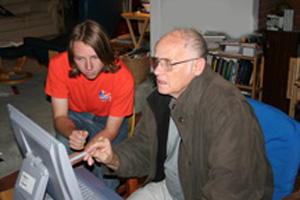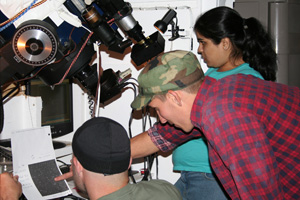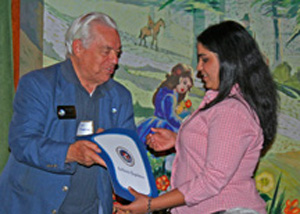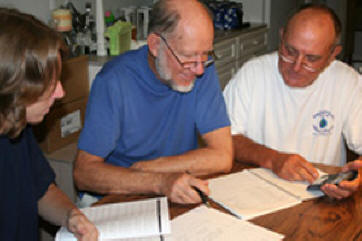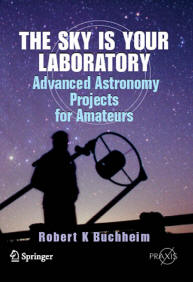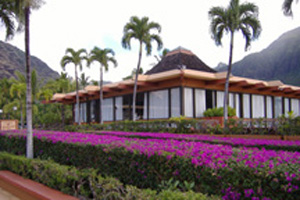|
1.
Amateur Research
Two decades ago, at the Eighth Annual
Fairborn-IAPPP Symposium, New Generation Small Telescopes, held
at the Saguaro Lake Ranch in Arizona, Robert A. Stebbins, a sociologist
from the University of Calgary, stated the following:
In the
wider community, the thought that amateurs might contribute anything
other than, perhaps, money and goodwill to professional science is only
slightly less than preposterous. Science, according to the popular
conception, is a highly technical and oftentimes abstract undertaking
mastered only by [those] with a unique bent for intellectual esoterica
and a passion for such cloisters as the library and the laboratory. The
scientist is a special strain of humanity who develops into a social
curiosity after years of specialized education and unstinting dedication
to the solutions of problems so arcane that the average citizen can only
marvel at their incomprehensibility. This is the public’s image of
science and the profession of scientists.
That
some people might try from time to time to enter this lofty realm purely
for the fun of it, for leisure, is even more inscrutable than science
itself and the professionals who work there. And when some of these
leisure-seeking “eccentrics” indicate that they occasionally contribute
something new to the science they are pursuing, the man in the street is
more likely than not to disintegrate in utter disbelief. Science is for
the spectacled, half-bald, wild-eyed genius, not for the ordinary being
who lives next door. (Stebbins 1987.)
Stebbins went on to remark that
“notwithstanding these stereotypes, amateur scientists abound.” He
suggested they had, over the years, “made important contributions to
archeology, ornithology, and astronomy.”
Almost a decade before the conference at
Saguaro Lake Ranch, I had conducted my own informal survey of amateur
science and had selected astronomy as the field most likely to result in
published papers—the hallmark of science. I had examined every paper in
five years of a leading publication, the Astronomical Journal,
asking myself, as I reviewed each paper, could I have accomplished this
research? Writing many of the papers would have required a theoretical
background beyond my grasp, while others would have required making
observations through telescopes much larger than I could afford to
purchase or build. Over two-dozen papers caught my attention, however.
All were photoelectric observations of variable stars or asteroids with
telescopes of 16-inch aperture or less.
It should not have been surprising that
time-series photometry appeared to be the major contribution of smaller
telescopes to astronomical science. Photometry makes efficient use of
the meager photons available to smaller telescopes, while time-series
observations are well suited to those who operate their own
observatory.
2.
Undergraduate Student Research
The public perception of undergraduate
student researchers is similar to its perception of amateur
researchers. It is, of course, well accepted that graduate science
majors should conduct research. In fact, they must prove themselves
capable of original research if they are to receive a doctoral degree.
But it is not widely recognized, as is the case with amateurs, that
undergraduate students, including non-science majors, are quite capable
of conducting scientific research and that they, their schools, and
their local communities—not to mention the larger scientific
community—all benefit from undergraduate scientific research.
While it is entirely appropriate that
undergraduate students should learn the essentials of one or more of the
sciences in lecture courses, as well as master basic laboratory skills
while conducting “experiments” with known outcomes, they may, in this
process, obtain a distorted view of science and scientists. Science,
after all, is primarily concerned with the unknown, not the known.
While it could be argued that science majors will, soon enough, be
exposed to research in graduate school, might they benefit if exposed to
research while still undergraduates? Would non-science undergraduate
majors gain an entirely different impression of science if they
participated in actual research?
An increasing number of schools recognize
the positive contributions undergraduate research can make to student
learning and the furtherance of the true sprit of science—exploration of
the unknown—on the campus and also within the local community. In this
paper I discuss my own experience with undergraduate research at
community colleges.
3.
Research Program I: Cepheids
Six years ago, while teaching astronomy and
mathematics at the Superstition Mountain campus of Central Arizona
College, I organized, with the assistance of Cheryl Genet, a
one-semester astronomical research class (Fall 2001). Nine students
were formed into three teams. All three teams chose to observe bright
Cepheid stars using a robotic telescope at the Fairborn Observatory in
southern Arizona.
Astronomer Kenneth Kissell discussed the
project with the students during several conference calls and assisted
them in selecting appropriate Cephids. Michael Seeds, the Principal
Astronomer for the Phoenix-10 robotic telescope at the Fairborn
Observatory, also spoke with the students during conference calls and
helped them with their observational requests. Douglas Hall aided the
students in selecting appropriate comparison and check stars, while
Louis Boyd operated the robotic telescope.
The Phoenix-10 robotic telescope obtained
the student-requested UBV photometric observations of the selected
Cepheids. Results became available toward the end of the semester and,
in several late-night sessions, the students tabulated and plotted
differential magnitudes as time series which, of course, appeared quite
random. They then produced phase plots and, as if by magic, the Cepheid
light curves appeared. They were most impressed!
One student, only 16 years old at the time,
presented his results on T Vul at the 200th meeting of the
American Astronomical Society (Lappa 2002). Cheryl Genet presented her
results on U Aql (Genet 2002) at the same meeting, while Cheryl and I
described the research course itself (Genet and Genet 2002).
4.
Research Program II: GNAT
The following year, Cheryl and I moved to
California’s Central Coast (near San Luis Obispo) to be near her aging
parents. I established the Orion Observatory and equipped it with a
10-inch Meade LX-200 telescope and SBIG ST-8 CCD camera. Thomas Smith,
at the nearby Dark Ridge Observatory, and I collaborated in observations
of short-period W UMa eclipsing binaries. I also taught introductory
astronomy part time at nearby Cuesta College,
Cuesta College seemed to be an appropriate
venue for another community college astronomical research course, and I
was allowed to offer such a course as a physics research seminar in the
fall of 2006. Three students— Neelie Jaggi, Casey Milne, and Noll
Roberts—worked together as a team to obtain light curves and determine
the periods of GNAT MG1 catalog stars whose periods, due to heavy
aliasing, were unknown. CCD photometry was obtained on nine MG1 stars
at the Orion Observatory. Two were found to be continuously variable,
and their periods were determined with precision. The students wrote up
their results, obtained reviews, and submitted their paper to the
Journal of the American Association of Variable Star Observers, a
respected, refereed journal, for the editor’s consideration (Roberts et
al 2006). This research was also summarized at the 209th
meeting of the American Astronomical Society (Roberts et al 2007).
The three keys to the student’s success were: (1)
the considerable help of an experienced local amateur astronomer, Thomas
Smith; (2) suggested observational candidates, assistance, and visits by
the director of the Global Network of Astronomical Telescopes (GNAT)
program, Eric Craine, and (3) much hard work by the students themselves.
Cuesta College faculty and staff were very supportive of this “pilot”
program, although it was understood that any repeat of the course, to be
viable, would need to enroll a dozen students.
5.
Research Program III: Scaling Up
Cuesta College has scheduled a second physics
research seminar for this coming fall (2007). We plan, again, to
observe potential short-term variables selected from the GNAT MG1
catalog. We also plan to obtain an asteroid light curve and determine
its rotational period. This research seminar should involve about a
dozen students (including a few high school students and several local
amateur astronomers) and several CCD-equipped, semi-automatic
telescopes. Potential solutions to problems in “scaling-up” last fall’s
pilot program are discussed below.
A single research team of a dozen or more students
would be unwieldy, so the research seminar will be organized around
multiple teams—each provided with the use of its own CCD-equipped, go-to
telescope. A student, Brittany McCrigler, loaned the Orion Observatory a
Meade 12-inch LX-200, and the observatory supplied a permanent pier,
equatorial wedge, and guidescope for this telescope. Two additional CCD
cameras with built-in B, V, and I filters (SBIG ST402) were purchased
with funds granted by the American Astronomical Society. James
Carlisle, at the Hill House Observatory in nearby Atascadero, recently
purchased a Meade 14-inch RCX 400 telescope and SBIG ST402 camera. He
will make these available at his observatory to one of the teams.
Finally, Tom Smith will be providing time (remotely) on his 14-inch
LX-200 GPS telescope from the Dark Ridge Observatory’s new home under
the clear skies of New Mexico.
Last fall, the single team with just three students
was able to use the computer and software at the Orion Observatory for
data reduction and analysis, although this required considerable student
travel. Such an arrangement would be cumbersome for a seminar with a
dozen students, multiple teams, and telescopes at several different
locations. It would be more efficient for each student to have
reduction and analysis software installed on their own laptop computer,
which they could take to the weekly seminar meetings for software
instruction, to observing runs to retrieve data and, of course, to their
homes for data reduction and analysis.
There are many excellent software programs
available for the reduction and analysis of time-series CCD photometry
that can be installed on laptop PCs. These include Maxum-DL, AIP4WIN,
CCD Soft, and MIRA. In choosing software for this coming fall’s
research seminar, two factors were paramount: (1) completeness in terms
of reduction and analysis for both variable star and rotating asteroid
time-series photometry, including period determination; and (2) low cost
per student. MPO Canopus/Photometric Reduction software was chosen for
the seminar this coming fall. It met our technical requirements and its
cost (educational license for five students) is only $13 per student.
Last fall, students learned the basics of CCD
photometry and lightcurve analysis through informal discussions at the
Orion Observatory. The seminar this coming fall will, instead, meet
formally every Monday evening at Cuesta College where students will
learn the fundamentals of time-series photometry via lectures. A
textbook, A Practical Guide to Lightcurve Photometry and Analysis
(Warner 2007), will provide the essentials of variable star and asteroid
time-series CCD photometry and analysis. This book is available from
Amazon for less than $40.
This coming fall’s research seminar will not only
include Cuesta College students taking other courses at the college, but
also a number of high school students enrolling in this research seminar
as their first college course. In addition, several seasoned
observers—members of the Central Coast Astronomical Society—will be
enrolling in the course. Finally, we expect a few undergraduate
students from California Polytechnic State University to participate.
The mix of high school students, community college students, university
undergraduate students, and local amateur astronomers should not only be
enriching to all concerned, but should help to inform and involve the
local community with respect to the rewards (and tribulations) of
scientific research.
Three preparatory activities are being undertaken
prior to this fall’s research seminar. They are: (1) an informal spring
student research effort; (2) a conference, Time Series Astronomical
Photometry, 22-24 June, at California Polytechnic State University;
and (3) a two-day training workshop on MPO Canopus/Photometric Reduction
software that will be taught by Brian Warner July 27-28 at a workshop in
Ft. Collins, Colorado.
6.
Conclusions
Amateurs, undergraduate college students, and high
school students are quite capable of scientific research and have, for
years, been successfully completing projects resulting in published
papers. Time-series CCD photometry of intrinsically variable stars,
eclipsing binaries, asteroids, and planets transiting distant stars are
a particularly fertile area for such research because the combination of
compact Schmidt-Cassegrain go-to telescopes, highly sensitive CCD
cameras, and very capable personal computers has transformed backyard
and college campus observatories into powerful scientific research
facilities.
Large-scale automated surveys at a number of
professional observatories have uncovered tantalizing hints of
astronomical objects whose true nature can be determined through the
dedicated time-series CCD photometry that properly-equipped amateur and
campus observatories can provide. Affordable, high-tech telescopes,
cameras, and computers have opened the door wide to amateurs and
students who wish to conduct cutting-edge scientific research.
Of course there is a catch—there always is!
Science is never easy. A basic understanding of CCD photometry of
variable stars and asteroids is required. CCD time-series photometry
also requires understanding and operating highly complex (albeit
affordable) equipment. Observations must be made for many hours on
multiple nights. Gigabytes of data have to be reduced and analyzed with
sophisticated software. Finally, results must be described in a paper,
the paper reviewed by outside experts, rewritten, and submitted for
publication. In the upcoming Fall 2007 research seminar discussed
above, all this will, as in last fall’s course, have to be accomplished
by busy students within the confines of a single semester.
Although daunting, the rewards of successfully
completed undergraduate (and high school) research are significant. As
coauthors of published scientific research papers, students not only
receive a boost with respect to their future educational opportunities,
but gain an understanding of the true nature of science and an
appreciation of how research is actually conducted. The word gets
around; there are other areas besides football and basketball where
students can shine!
7.
Acknowledgements
I am pleased to acknowledge the assistance of
several individuals in scheduling, organizing and conducting last fall’s
research seminar. Thomas Smith (Dark Ridge Observatory); Eric Craine
(GNAT Program); Kathie Jimison, Cathie Babb, and Pat Len (Cuesta
College); Kenneth Kissell (Kissell Associates); and, especially, the
course’s three students, Neelie Jaggi, Casey Milne, and Noll Roberts
(Cuesta College), all helped to make this course possible. Also, my
thanks, in advance, to those who are helping pave the way for this
coming fall’s research seminar.
This research was partially supported by a grant
from the American Astronomical Society.
8.
References
Genet, C. L., 2002. “Photoelectric Photometry of
the Bright Cepheid U Aql.” Bulletin of the American Astronomical
Society, 34, 7.01.
Genet, R. M., and C. L. Genet, 2002. “Community
College Class Devoted to Astronomical Research.” Bulletin of the
American Astronomical Society, 34, 13.08.
Lapa, K., 2002. “Observations of the Cepheid T Vul.”
Bulletin of the American Astronomical Society, 34, 7.02.
Roberts, N., C. Milne, and N. Jaggi, 2006. “Light
Curves of Two GNAT MG1 Survey Stars.” Submitted to the Journal of
the American Association of Variable Star Observers.
Roberts, N., N. Jaggi, and C. Milne, 2007. “GNAT
Student Follow-up Pilot Project.” Bulletin of the American Astronomical
Society, 39, 162.09.
Stebbins, R. A., 1987. “Amateurs and Their Place
in Professional Science.” In New Generation Small Telescopes, D.
S. Hayes, D. R. Genet, and R. M. Genet, eds. Mesa, AZ: Fairborn
Press.
Warner, B. D., 2007. A Practical Guide to
Lightcurve Photometry and Analysis. New York: Springer.
|
